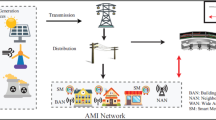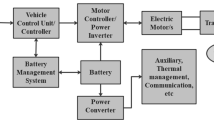Abstract
Partial Discharge (PD) checking is a standout amongst the best technique for insulation condition evaluation of HV power system. PD releases inside a power transformer energize electromagnetic transients that can be identified utilizing sensors working in the ultra-high frequency band. Despite, on-line PD estimations are influenced by elevated amounts of electromagnetic interference that makes delicate PD identification exceptionally troublesome. In our proposed research present an approach which can reduce the noise level. Increase the quality of the PD signal. Here using an approximation logic which can reduce the complexity in terms of time and able to improve the quality. The proposed Double DWT able to get batter result as compares to existing PD techniques.










Similar content being viewed by others
References
Naidu, M. S., & Kamaraju, V. (2007). High voltage engineering (3rd ed.). New York: Tata McGraw-Hill.
Maheswari, R. V., Arunadevi, I., Willjuice Iruthayarajan, M., & Subburaj, P. (2012). Partial discharge modeling based on cavities of different shapes within solid dielectrics. International Journal of Communications and Engineering, 4(4), 138–144.
Anandakumar, H., & Umamaheswari, K. (2017). An efficient optimized handover in cognitive radio networks using cooperative spectrum sensing. Intelligent Automation and Soft Computing. https://doi.org/10.1080/10798587.2017.1364931.
Ganjun, W., Fan, Y., Xiaosheng, P., Yijiang, W., Taiwei, L., & Zibo, L. (2018). Partial discharge pattern recognition of high voltage cables based on the stacked denoising autoencoder method. In: 2018 International conference on power system technology (POWERCON).
Mal, X., Zhou, C., & Kcmp, J. (2000). Investigation into the use of wavelet theory for partial discharge pulse extraction in electrically, noisy environments. In Proceedings of 8th International Conference on Materials, Measurements and wseas transactions on circuits and systems Zhou-Sheng Zhang and Deng-Ming Xiao. ISSN: 1109-2734 544 (Vol. 7(6), pp. 123–126). Applications, Edinburgh, UK.
Anandakumar, H., & Umamaheswari, K. (2017). Supervised machine learning techniques in cognitive radio networks during cooperative spectrum handovers. Cluster Computing, 20(2), 1505–1515.
Xiao Yan, Y., Weiyong, H. C., & Chuanwen, J. (2005). Suppression of partial discharge’s discrete spectral interference based on spectrum estimation and wavelet packet transform. WSEAS Transactions on Circuits and Systems, 4(11), 1508–1515.
Anandakumar, H., & Umamaheswari, K. (2018). A bio-inspired swarm intelligence technique for social aware cognitive radio handovers. Computers and Electrical Engineering, 71, 925–937.
Naderi, M. S., Vakilian, M., Blackburn, T. R., Phung, B. T., & Naderi, M. S. (2006). A new technique for extracting partial discharge signals in transformer winding by application of wavelet analysis. WSEAS Transactions on Power Systems, 1(1), 77–83.
Zhu, J., He, B., Wang, X., Cui, L., & Li, Y. (2018). Extraction of partial discharge signal feature based on dual-tree complex wavelet transform and singular-value decomposition. In 2018 Condition monitoring and diagnosis (CMD).
Bidhendi, H. N., Su, Q. (1997). Partial discharge location on power cables using linear prediction. In: IEEE 5th International conference on properties and applications of dielectric materials, Seoul, Korea.
Walton, C. M. (2001). Detecting and locating MV failure before it occurs. In: Experience with live line partial discharge detection on underground paper insulated 11 kv cables in London IEE CIRED. 2001 Conference.
Boggs, S., Pathak, A., & Walker, P. (1996). Partial discharge XXII: High frequency attenuation in shielded solid dielectric power cable and implications thereof for PD location. IEEE Electrical Insulation Magazine, 12(1), 9–16.
Shim, I., Soraghan, J. J., & Siew, W. H. (2000). Digital signal processing applied to the detection of partial discharge: An overview. IEEE Electrical Insulation Magazine, 16(3), 6–12.
Hussein, R., BashirShaban, K., & El-Hag, A. H. (2016). Denoising of acoustic partial discharge signals corrupted with random noise. IEEE Transactions on Dielectrics and Electrical Insulation, 23(3), 1453–1459.
Satish, L., & Nazneen, B. (2003). Wavelet-based denoising of partial discharge signals buried in excessive noise and interference. IEEE Transactions on Dielectrics and Electrical Insulation, 10(2), 354–367.
do Batista, P. V. C., de Mota, H. O., Ferreira, G. M., de Silva, F. T. A. & Vasconcelos, F. H. (2018). Wavelet total variation method applied to partial discharge signal denoising. In 2018 3rd International symposium on instrumentation systems, circuits and transducers (INSCIT).
Raghunath, S. S., & Narasimham, S. V. L. (2016). Application of wavelet transform technique for extraction of partial discharge signal in a transformer. International Journal of Engineering, 8(2), 247–258.
Anandakumar, H., Umamaheswari, K., & Arulmurugan, R. (2018). A study on mobile IPv6 handover in cognitive radio networks. In Lecture notes on data engineering and communications technologies (pp. 399–408).
Si, W., Qin, B., Li, Q., & Liu, H. (2019). A novel adaptive wavelet threshold estimation based on hybrid particle swarm optimization for partial discharge signal denoising. Optik, 181, 175–184.
Zhou, X., Zhou, C., & Kemp, I. J. (2005). An improved methodology for application of wavelet transform to partial discharge measurement denoising. IEEE Transactions on Dielectrics and Electrical Insula -tion, 12(3), 586–594.
Li, G., Guan, Q., & Yang, H. (2018). Noise reduction method of underwater acoustic signals based on CEEMDAN, effort-to-compress complexity, refined composite multiscale dispersion entropy and wavelet threshold denoising. Entropy, 21(1), 11.
Song, X., Zhou, C., Hepburn, D. M., & Zhang, G. (2007). Second generation wavelet transform for data denoising in PD measurement. IEEE Transactions on Dielectrics and Electrical Insulation, 14(6), 1531–1537.
Hao, Z. et al. (2007). A novel wavelet transforms technique for on-line partial discharge measurements. 1. WT de-noising algorithm. In IEEE transactions on dielectrics and electrical insulation (Vol. 14.1).
Arulmurugan, R., Sabarmathi, K. R., & Anandakumar, H. (2017). Classification of sentence level sentiment analysis using cloud machine learning techniques. Cluster Computing. https://doi.org/10.1007/s10586-017-1200-1.
Author information
Authors and Affiliations
Corresponding author
Additional information
Publisher's Note
Springer Nature remains neutral with regard to jurisdictional claims in published maps and institutional affiliations.
Rights and permissions
About this article
Cite this article
Sharif, M.I., Li, J.P. & Sharif, A. A Noise Reduction Based Wavelet Denoising System for Partial Discharge Signal. Wireless Pers Commun 108, 1329–1343 (2019). https://doi.org/10.1007/s11277-019-06471-2
Published:
Issue Date:
DOI: https://doi.org/10.1007/s11277-019-06471-2




